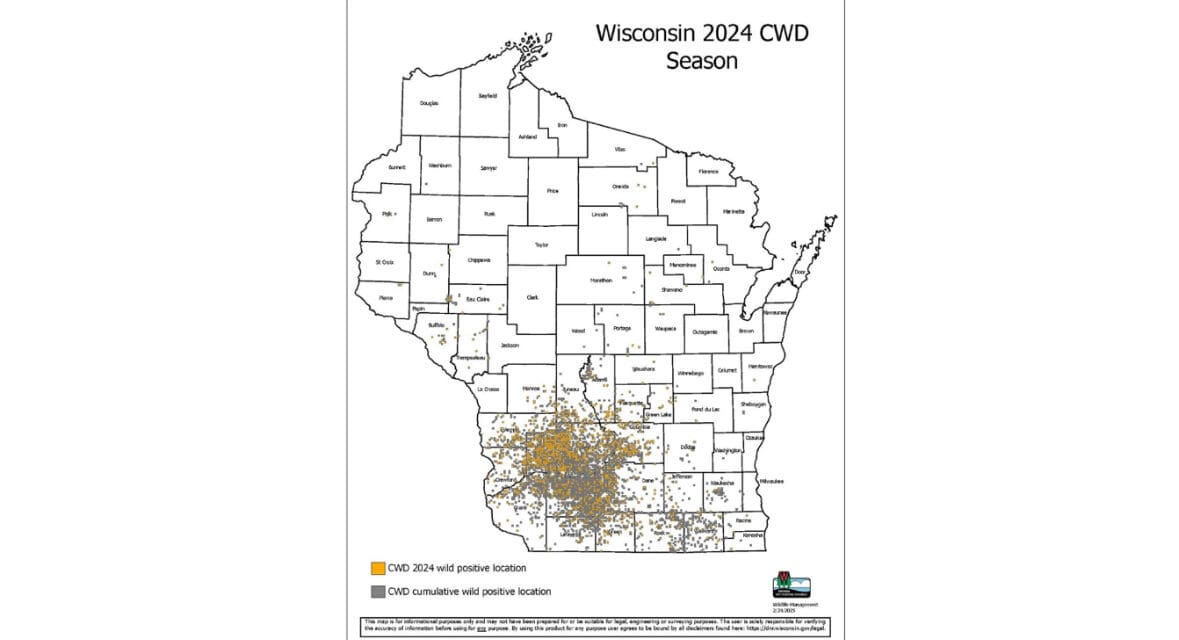The Wisconsin Department of Natural Resources announced the results of its 2024 Chronic Wasting Disease sampling efforts, revealing 1,786 positive cases out of 17,399 deer tested statewide. The majority of detections, 89%, occurred in the Southern Farmland Zone, where 7,680 samples yielded 1,583 positives.
The DNR intensified sampling in designated 2024 Fall Priority Areas, selected based on recent CWD detections in wild and farm-raised deer, primarily in central and northern Wisconsin. This targeted approach helped the agency assess disease prevalence and distribution in areas with emerging cases. Statewide, testing was available at 242 locations, including 166 self-service kiosks and 76 staffed sites. Hunters received results in an average of 8.4 days.
New detections were reported in several counties. Pierce and Menominee recorded their first wild CWD positives, while Polk and Vilas each confirmed a second case. Oneida County reported three additional positives in its eastern region. In eastern Wisconsin, Waushara and Fond du Lac, previously with one detection each, identified multiple new cases, and Waupaca and Shawano confirmed their third and additional positives, respectively. Western and central counties, including Adams, Buffalo, Dunn, Eau Claire, Jackson, Juneau, Marathon, Monroe, Portage, and Trempealeau, also reported positives.
Outside priority areas, Chippewa and Manitowoc counties detected their first wild positives, and Oconto County identified a second case, three years after its initial detection.
In southwest Wisconsin, where CWD was first discovered, a recent study presented to the Natural Resources Board highlighted the disease’s impact. The Southwest Wisconsin CWD, Deer and Predator Study found that CWD significantly reduces deer survival, suppresses population growth, and may lead to declines in areas with high prevalence. While southern Wisconsin counties show elevated prevalence, rates vary within counties and across the state.
Erin Larson, DNR deer herd health specialist, emphasized the importance of continued vigilance. “Although we have detected CWD in new areas of the state in recent years, many of these areas are at a low prevalence rate, and opportunities still remain to slow the spread and growth of the disease statewide,” Larson said.
The DNR expressed gratitude to hunters who submitted samples, as well as businesses and partners managing the 242 sampling sites and 154 carcass disposal locations, including dumpsters, landfills, and transfer stations. Partnerships like Adopt-a-Kiosk and Adopt-a-Dumpster supported these efforts.
Public health officials continue to advise against consuming meat from CWD-positive deer and recommend testing, particularly in high-prevalence areas. No human cases of CWD have been reported to date.
For the 2024 season, the DNR focused its efforts on increasing sample collection in designated 2024 Fall Priority Areas. As usual, testing was available statewide, but the additional samples tested from the priority areas helped the DNR better understand disease levels and distribution in areas with recent detections.
A full breakdown of sampled and positive totals by zone and year is available on the DNR’s Summary of CWD Statewide Surveillance webpage.
Additional details on these detections can be found on the CWD interactive map and CWD results page, which includes summaries by county and township.
















